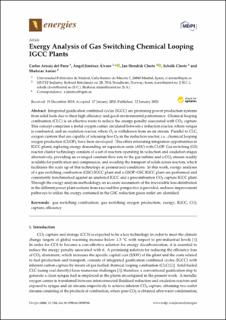Exergy Analysis of Gas Switching Chemical Looping IGCC Plants
del Pozo, Carlos Arnaiz; Álvaro, Ángel Jiménez; Cloete, Jan Hendrik; Cloete, Schalk Willem Petrus; Amini, Shahriar
Peer reviewed, Journal article
Published version
Permanent lenke
https://hdl.handle.net/11250/2834897Utgivelsesdato
2020Metadata
Vis full innførselSamlinger
- Publikasjoner fra CRIStin - SINTEF AS [5802]
- SINTEF Industri [1566]
Sammendrag
Integrated gasification combined cycles (IGCC) are promising power production systems from solid fuels due to their high efficiency and good environmental performance. Chemical looping combustion (CLC) is an effective route to reduce the energy penalty associated with CO2 capture. This concept comprises a metal oxygen carrier circulated between a reduction reactor, where syngas is combusted, and an oxidation reactor, where O2 is withdrawn from an air stream. Parallel to CLC, oxygen carriers that are capable of releasing free O2 in the reduction reactor, i.e., chemical looping oxygen production (CLOP), have been developed. This offers interesting integration opportunities in IGCC plants, replacing energy demanding air separation units (ASU) with CLOP. Gas switching (GS) reactor cluster technology consists of a set of reactors operating in reduction and oxidation stages alternatively, providing an averaged constant flow rate to the gas turbine and a CO2 stream readily available for purification and compression, and avoiding the transport of solids across reactors, which facilitates the scale up of this technology at pressurized conditions. In this work, exergy analyses of a gas switching combustion (GSC) IGCC plant and a GSOP–GSC IGCC plant are performed and consistently benchmarked against an unabated IGCC and a precombustion CO2 capture IGCC plant. Through the exergy analysis methodology, an accurate assessment of the irreversible loss distribution in the different power plant sections from a second-law perspective is provided, and new improvement pathways to utilize the exergy contained in the GSC reduction gases outlet are identified.

